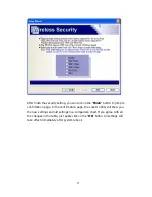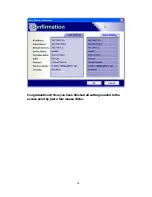
3
Roaming
Infrastructure mode also supports roaming capabilities for mobile users.
Roaming means that you can move your wireless PC within your network and
the access points will pick up the wireless PC's signal, providing that they both
share the same channel and SSID. Before enabling you consider roaming,
choose a feasible radio channel and optimum access point position. Proper
access point positioning combined with a clear radio signal will greatly enhance
performance.
Network Layout
The AP Access Point has been designed for use with 802.11g and 802.11b
products. With 802.11g products communicating with the 802.11b standard,
products using these standards can communicate with each other. The Access
point is compatible with 802.11g and 802.11b adapters, such at the PC Cards
for your laptop computers, PCI Card for your desktop PC, and USB Adapters for
when you want to enjoy USB connectivity. These wireless products can also
communicate with a 802.11g or 802.11b wireless Print Server. When you wish
to connect your wired network with your wireless network, the Access Point’s
network port can be used to connect to any of switches or routers.
Installation Considerations
The AP lets you access your network, using a wireless connection, from
virtually anywhere within its operating range. Keep in mind, however, that the
number, thickness and location of walls, ceilings, or other objects that the
wireless signals must pass through, may limit the range. Typical ranges vary
depending on the types of materials and background RF (radio frequency)
noise in your home or business. The key to maximizing wireless range is to
follow these basic guidelines:
z
Keep your product away (at least 3-6 feet or 1-2 meters) from electrical
devices or appliances that generate RF noise.
z
Keep the number of walls and ceilings between the AP and other network
devices to a minimum - each wall or ceiling can reduce your AP’s range
from 3-90 feet (1-30 meters.) Position your devices so that the number of
walls or ceilings is minimized.
z
Be aware of the direct line between network devices. A wall that is 1.5 feet
thick(.5 meters), at a 45-degree angle appears to be almost 3 feet (1
meter) thick. At a 2-degree angle it looks over 42 feet (14 meters) thick!
Position devices so that the signal will travel straight through a wall or
Summary of Contents for WH-5400CPE
Page 1: ...1 WH 5400CPE High Power Outdoor Solution User s manual ...
Page 7: ...7 Network Topology WDS Point to Multi Point Mode WDS P2MP Mode ...
Page 8: ...8 CPE Installation Diagram ...
Page 9: ...9 ...
Page 20: ...20 ...
Page 34: ...34 ...
Page 43: ...43 ...
Page 46: ...46 ...




































